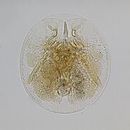fr
noms dans le fil d’Ariane


This species is common everywhere.
Testudinella patina is an euryhaline cosmopolitan species, common in freshwaters rich in submerged vegetation, but also regularly reported from the marine littoral, and brackish and inland saline waters
Planktic species and free-swimmers. It may be associated to the crustacean Asellus.
The lorica outline is almost circular or very weakly elliptical: ratio length/width 1.05–1.20. The ventral anterior margin has a broad and shallow median sinus; the dorsal anterior margin is weakly convex to almost straight, or shows three more or less pronounced shallow lobes. In dorsal/ventral view the lorica bears a band of irregular stipples of unequal diameter laterally and caudally, which in cross-sectional view appear to be the junctures of rod-shaped structures connecting the dorsal and ventral parts of the lorica. In crosssectional view the lorica margins are more or less sharp and protruding, the dorsal margin is flat or weakly convex, and the ventral margin is broadly arched and usually higher than the dorsal one. The foot opening is circular, situated ventrally near the middle or somewhat below the middle of the lorica. The distal foot pseudosegment is relatively short and only weakly offset from the wrinkled proximal part of the foot; penultimate pseudosegment absent or indistinct. The dorsal and lateral antennae are located at almost the same height: ratio lorica length/distance antennae from antero-dorsal margin 3.25–3.55. Two red eyespots.
The trophi have 12–16/12–16 (left/right) unci teeth, with very slender and only weakly offset heads; heads of major teeth fairly small. The manubria consist of three large superimposed chambers; sub-ventral chamber vestigial. The number of arched rami scleropili is ~31–32/30–31 (left/right). The fulcrum lacks a proximal opening frontally.
Lorica length 120-350 μm, lorica width 100-236 μm, distal foot pseudosegment 15–20 μm.